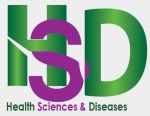Impact of Cardiovascular Factors on the Occurrence of Acute Coronary Syndrome with ST Segment Elevation in Burkina Faso: A Case Control Study
Impact des Facteurs Cardiovasculaires sur la Survenue du Syndrome Coronaire Aigu avec Sus-Décalage du Segment ST au Burkina Faso : Une Étude Cas Témoin
DOI:
https://doi.org/10.5281/hra.v2i12.6250Keywords:
Cardiovascular risk factors, acute coronary syndrome, Impact, Burkina FasoAbstract
RESUME
Introduction. Au Burkina Faso, la prévalence du syndrome coronaire aigu avec sus-décalage du segment ST (SCAST+) est en augmentation. Il est possible de prévenir la plupart des SCAST+ en s’attaquant aux facteurs de risque cardio-vasculaire. L’objectif de ce travail a été d’étudier l’impact des facteurs de risque cardio-vasculaire sur la survenue du SCAST+ au Burkina Faso. Méthodologie. Il s’agissait d’une étude observationnelle, de type cas-témoins, non appariés, un cas pour trois témoins, monocentrique, à recueil rétrospectif des donnés, allant du 1erJanvier 2010 au 31 Décembre 2016. Elle a inclus 1029 patients, soit 199 cas de SCAST+ et 830 témoins hospitalisés au sein du service de cardiologie du CHU-YO de Ouagadougou durant la période d’étude. Résultats. En analyse univariée et multivariée, les facteurs de risque cardio-vasculaire ayant impacté significativement (odds ratio ajusté [IC 95%]) la survenue du SCAST+ étaient : l’âge supérieur à 50 ans (5,96 [3,84-9,25]), le sexe masculin (3,97 [2,48-6,34]), le diabète (2,76 [1,56-4,89]), l’hypertension artérielle (2,14 [1,43-3,2]) et le tabagisme (2,09 [1,33-3,3]). Le cumul croissant des facteurs de risque cardio-vasculaire augmente significativement le risque de survenue du SCAST+ (p < 0,0005). L’odds ratio [IC 95%] de survenue d’une altération de la FEVG (FEVG < 50%) et de survenue d’un décès intrahospitalier en cas de SCAST+ était respectivement de 4,62 [2,67-7,98] et de 3,23 [1,85-5,66]. La prise en charge de l’hypertension artérielle, du diabète et du tabagisme, va permettre de réduire 72% de la fréquence de survenue du SCAST+. Conclusion. La prévention et le contrôle des facteurs de risque cardiovasculaire au Burkina Faso réduirait de plus de 72% le risque de survenu d’un syndrome coronarien aigu.
ABSTRACT
Introduction. In Burkina Faso, the prevalence of acute coronary syndrome with ST-segment elevation (SCAST+) is increasing. Most SCAST+ can be prevented by addressing cardiovascular risk factors. The aim of this study was to investigate the impact of cardiovascular risk factors on the occurrence of SCAST+ in Burkina Faso. Methodology. This was an observational, case-control, unmatched, one-case, three-control, single-centre study with retrospective data collection from 1 January 2010 to 31 December 2016. It included 1029 patients (199 SCAST+ cases and 830 controls) hospitalised in the cardiology department of the CHU-YO in Ouagadougou during the study period. Results. In univariate and multivariate analysis, the cardiovascular risk factors that had a significant impact (adjusted odds ratio [95% CI]) on the occurrence of SCAST+ were : age over 50 (5.96 [3.84-9.25]), male sex (3.97 [2.48-6.34]), diabetes (2.76 [1.56-4.89]), arterial hypertension (2.14 [1.43-3.2]) and smoking (2.09 [1.33-3.3]). Increasing accumulation of cardiovascular risk factors significantly increased the risk of SCAST+ (p<0.0005). The odds ratios [95% CI] for LVEF impairment (LVEF < 50%) and for in-hospital death in the event of SCAST+ were 4.62 [2.67-7.98] and 3.23 [1.85-5.66] respectively. Management of hypertension, diabetes and smoking reduced the incidence of SCAST+ by 72%. Conclusion. Prevention and control of cardiovascular risk factors in Burkina Faso would reduce the risk of acute coronary syndrome by more than 72%.
References
Yusuf, S. et al.: Effect of potentially modifiable risk factors associated with myocardial infarction in 52 countries (the Interheart study): case-control study. The Lancet. 364, 9438, 937–952 (2004).
Chesler E, Mitha AS, Weir EK, Matisonn RE, Hitchcock PJ. Myocardial infarction in the black population of South Africa: coronary arteriographic findings. Am Heart J. 1978;95:691–696.
Seedat YK, Mayet FGH, Latiff GH, Joubert G. Risk factors and coronary heart disease in Durban blacks: the missing links. S Afr Med J. 1992;82:251–256.
Seftel HC. The rarity of coronary heart disease in South African blacks. S Afr Med J. 1978;54:99–105.
Walker ARP, Sareli P. Coronary heart disease: outlook for Africa. J R Soc Med. 1997;90:23–27.
Ticolat P, Bertand Ed. Aspects épidémiologiques de la maladie coronaire chez le Noir Africain : A propos de 103 cas. Résultats de l’enquête multicentrique prospective CORONAFRIC. Cardiol Trop 1991;17: 6-18.
Damorou F. et al. Morbidité et mortalité hospitalière des maladies cardio-vasculaires en milieu tropical : exemple d’un centre hospitalier à Lomé (Togo). Pan Afr. Med. J. 17, 1, (2014).
Mboup, M.C. et al.: Les syndromes coronaires aigus à Dakar: aspects cliniques thérapeutiques et évolutifs. Pan Afr. Med. J. 19, 126, (2014).
N’Guetta, R. et al.: Prévalence et caractéristiques des syndromes coronariens aigus dans une population d’Afrique subsaharienne. Ann. Cardiol. Angéiologie. 65, 2, 59–63 (2016).
Nobila Valentin, Y. et al.: L’infarctus du myocarde du jeune adulte -Analyse rétrospective des cas colligés au CHU de Dakar. Pan Afr. Med. J. 6, (2010).
Samadoulougou, A.K. et al.: Aspects épidémiologiques, cliniques et évolutifs des cardiopathies ischémiques dans le service de cardiologie du Centre Hospitalier Universitaire Yalgado Ouedraogo à Ouagadougou. Médecine Afr. Noire. 58, 1, 14–18 (2011).
Ba A. Epidémiologie de la coronaropathie en Afrique. Congrès APPAC, 8-10 Juin 2016. Biarritz.
Steyn, K. et al.: Risk factors associated with myocardial infarction in Africa: the Interheart Africa study. Circulation. 112, 23, 3554–3561 (2005).
Danet, S. et al.: Unhealthy effects of atmospheric temperature and pressure on the occurrence of myocardial infarction and coronary deaths. Circulation. 100, 1, e1–e7 (1999).
Tunstall-Pedoe H, Kuu lemme K, Mahonen M, Tolonen H, Ruokokoski E, Amouyel P. Contribution of trends in survival and coronary-event rates ta changes in coroner): heart disease mortality: 10-yeal- results from 37 WHO MONICA project populations. Monitoring trends and detenninants in cardiovascular disease. Lancer 1999;353:1547-57.
Soubeiga, J.K. et al.: Prevalence and factors associated with hypertension in Burkina Faso: a countrywide cross-sectional study. BMC Public Health. 17, 64 (2017).
Dean AG, Sullivan KM, Soe MM. OpenEpi: Open Source Epidemiologic Statistics for Public Health, Version. www.OpenEpi.com, mis à jour 2013/04/06, accédé 2017/11/17. [Internet]. [cité 13 oct 2017]. Disponible sur: http://www.openepi.com/Menu/OE_Menu.htm
Soubeiga JK, Millogo T, Bicaba BW, Doulougou B, Kouanda S. Prevalence and factors associated with hypertension in Burkina Faso: a countrywide cross-sectional study. BMC Public Health. 2017;17:64.
Steyn K, Sliwa K, Hawken S, Commerford P, Onen C, Damasceno A, et al. Risk factors associated with myocardial infarction in Africa: the INTERHEART Africa study. Circulation. 2005;112:3554‑61.
Jackson R, Chambless LE, Higgins M, Kuulasmaa K, Wijnberg L, Williams OD. Gender differences in ischemic heart disease mortality and risk factors in 46 communities: an ecological analysis. Journal of Cardiovasc Risk. 1997;7:43–54.
Collins P, Rosano G, Casey C, Daly C, Gambacciani M, Hadji P. Management of cardiovascular risk in the peri-menopausal woman : a consensus statement of European cardiologists and gynaecologists. Eur Heart J 2007 ;28 :2028-40.
Puymirat E, Simon T, Cayla G, Cottin Y, Elbaz M, Coste P et al. Acute Myocardial Infarction: Changes in Patient Characteristics, Management, and 6-Month Outcomes over a Period of 20 Years in the FAST-MI Program (French Registry of Acute ST-Elevation or Non-ST-elevation Myocardial Infarction) 1995 to 2015. Circulation 2017.
Bassand JP, Vullemenot A. Reperméabilisation coronaire à la phase aiguë de l’infarctus du myocarde. Reg_ Prat. 1995 ; 45 2137 - 2141.
Collart P, Coppleters Të, Draibilux M et al. Infarctus du myocarde à Charleroi évolution des facteurs de risque et des pratiques thérapeutiques. Ann Cardiologie Ang 2013, 62 :233-49.
Dioum M. Les syndromes coronariens aigus chez le sujet âgé étude transversale à propos de .47 cas. Thé..selteci, Dakar 2009 ND138.
Donzeau-gouge p, Piwnica A. Intérêt de la contre-pulsion par ballon intra aortique dans le traitement des complications mécaniques de l’infarctus du myocarde à la phase aigué. Anis Chi?’ 1986 ; 40 :552-5.
Maurin, O. et al.: Infarctus du myocarde en phase aiguë à Djibouti : étude prospective sur deux ans. Médecine Santé Trop. 22, 3, 297–301 (2012).
Pessinaba S, Baragou S, Atti YDM, Pio M, Afassinou Y, Kplélafia M et al. Syndrome coronarien aigu : aspects épidémiologique, clinique, paraclinique et thérapeutique au CHU campus de Lomé. Cardiol trop.2013 : 27.
Steg PG, James SK, Atar D, Badano LP, Blomtrom-Lundqvist C, Borger MA, et al. ESC Guidelines for the management of acute myocardial infarction in patients presenting with ST- segment elevation. Eur Heart J 2012; 33: 2569–619.
Hocidian J, Apolito R. The calmafter the storm. J Am ColiCardiol 2007 : 50 : 1759-60.
Iglesias JF, Roguelow C. Kabir T et al. Les indications à la coronarographie en urgence. Rev Med Suisse 2009 ; 5 :1195-201.
Bensouda C, Otel I, Danchin N. Aspects cliniques des syndromes coronariens aigus. Med Sei 2004; 20: 402-7.
Dancien N, Blanchard D, Steg P’G et al. Impact of prehospital thrombolysis for acute myocardial infarction on 1 rear outcome. Result from the French nationwide USIC 2000 registry. Circulation 2004 ; 110 : 1909-15.
Downloads
Published
How to Cite
Issue
Section
License
Copyright (c) 2024 Hermann Nestor Tsague Kengni, Anna Thiam, Laurence Carole Ngo Yon, Seck M’baye M’baye Salissou, Hybi Langtar Mianroh, Hamidou Louan, Laurence Eudoxie Benon/Kabore, Nobila Valentin Yameogo, Patrice Zabsonre

This work is licensed under a Creative Commons Attribution-NonCommercial-NoDerivatives 4.0 International License.
Authors who publish with this journal agree to the following terms:
- Authors retain copyright and grant the journal right of first publication with the work simultaneously licensed under a Creative Commons Attribution License CC BY-NC-ND 4.0 that allows others to share the work with an acknowledgement of the work's authorship and initial publication in this journal.
- Authors are able to enter into separate, additional contractual arrangements for the non-exclusive distribution of the journal's published version of the work (e.g., post it to an institutional repository or publish it in a book), with an acknowledgement of its initial publication in this journal.
- Authors are permitted and encouraged to post their work online (e.g., in institutional repositories or on their website) prior to and during the submission process, as it can lead to productive exchanges, as well as earlier and greater citation of published work










